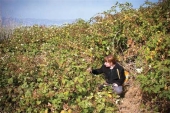


The aim of this investigation was to study the effect of sustainable strategies to correct iron deficiency in blueberries, based on Fe-heme applications or intercropping with graminaceous species, on yield, and berry quality variables. The experiment was conducted in a blueberry orchard established in a sub-alkaline soil. The association with grasses increased the crop load and yield (only Festuca rubra), and decreased the skin/flesh ratio. In addition, these treatments increased anthocyanins as well as some hydroxybenzoic acids, hydroxycinnamic acids, flavanols, and flavonol concentrations in skins with a similar effectiveness as Fe-EDDHA, whereas the Fe-heme applications did not influence such parameters. Moreover, data revealed that the association with both grasses decreased the firmness of the berries, whereas none of the treatments assessed changed the soluble solids, pH, acidity, and the soluble solids/acidity rate compared to the control.
The graminaceous species F. rubra L. and P. pratensis L were sown over the rows in autumn 2014 at a density of 20,000 seeds m-2. During the season, the graminaceous species were cut manually to a height of 5 cm every time they reached 15 cm.



Barbara Kochan wrote:You may find that his exceptional fastidiousness is due to a very keen observation and that, but for lesser fine motor skills even this 2.5 years old person could put each seed back with it's kindred, given a few attention breaks.

Douglas Alpenstock wrote:For those who prefer to avoid plastic in the garden, I wonder if overlapping 12" ceramic tiles would be deep enough. I've read that the runners tend to be shallower than the roots of the mature plant. Tile can be had very cheap/free if you know where to look.
